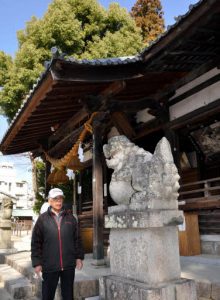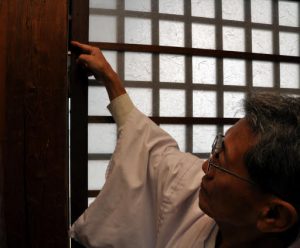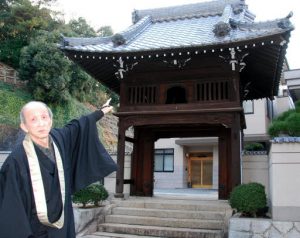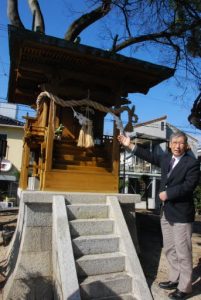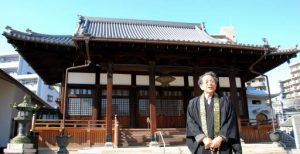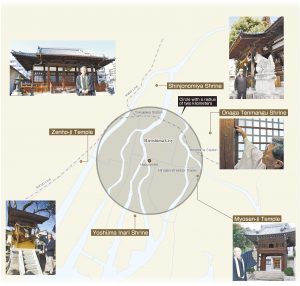Peace Seeds: Teens in Hiroshima Sow Seeds of Peace (Part 65)
Feb. 21, 2019
Part 65: Visiting temples and shrines that survived the atomic bombing
In the city of Hiroshima, there are a number of A-bombed structures that can convey the tragedy of the atomic bombing. Among them are wooden buildings that were scarred by the blast at some distance from the hypocenter, most of which are temples and shrines. The junior writers of the Chugoku Shimbun paid visits to five A-bombed temples and shrines. While buildings within a two-kilometer radius from the hypocenter were either completely destroyed or burnt to the ground, these buildings are at a distance of about two kilometers or so from ground zero. And they can tell us about the time of the atomic bombing.
It isn’t hard to find temples and shrines like this around us, which hold memories of the A-bomb attack. By visiting these places, and hearing their silent messages, we can appreciate how priceless peace is.
Shinjonomiya Shrine: Trees protected it from fire
The worship hall of Shinjonomiya Shrine in Nishi Ward was built in 1835 and continues to exude dignity. Standing by the hall is a 500-year-old camphor tree, as well as other trees that include a Aphananthe aspera. These trees are believed to have blocked approaching flames and saved the shrine.
The Shinjonomiya Shrine is located 2.9 kilometers to the north of the hypocenter. After the war, the condition of the structure deteriorated, its pillars becoming rotten and infested with worms, so it had to be repaired extensively in 2004. Shigeo Ochi, 76, an A-bomb survivor who helps take care of the shrine as a representative of his neighborhood, said, “This shrine is a symbol of our community. We want to preserve it as a survivor of the atomic bombing.” The grounds of the shrine are a peaceful place with quiet trees and the sounds of birds. (Honoka Hiramatsu, 15)
Onaga Tenmangu Shrine: Gap remains between door and leaning pillar
Onaga Tenmangu Shurine is located in Higashi Ward and is 2.6 kilometers to the northeast of the hypocenter. As we entered the hall of worship, a ray of light shone through a crack between the door and the pillar, which is one centimeter wide at most. Kiyoomi Watanabe, 64, the head priest of the shrine, explained that this is a remnant of the A-bomb blast, which made the building lean toward the southeast.
The hall of worship was moved here from Nigitsu Shrine in 1937. The crack created by the blast was five centimeters wide. It had been boarded up until 2006, when restoration work was completed after the roof of the building suffered a bad leak. Although the tiles on the roof were replaced, the tilt of the structure was not fully fixed.
The shrine’s metallic guardian dogs had to be given to the government during the war, so the metal could be used by the military, but they found new life as a stone statue in 1956. Unlike the north side of Hiroshima Station, which has undergone extensive changes through recent redevelopment, the shrine area still bears scars from the atomic bombing. (Hitoha Katsura, 14)
Myosen-ji Temple: Protecting the temple gate from a redevelopment project
Myosen-ji Temple in Minami Ward was located 1.9 kilometers to the east of the hypocenter at the time of the atomic bombing. The entire temple complex except the temple gate, which was built around 1921, was destroyed. When a plan to redevelop the area was put forth in the 1990s, the head priest of the temple, Siho Akezumi, 69, wasn’t sure what to do about the gate, whether the gate should be preserved or not. After discussing this issue with Hiroshima City officials many times, he made up his mind to save the gate, and had it moved to newly developed land.
He reached this decision after seeing other A-bombed temples and coming to the realization that most of them have preserved their A-bombed gate even after they rebuilt other buildings that were destroyed by fire. He thought, “I shouldn’t demolish the gate that survived the atomic bombing.”
The gate was reinforced with iron pipes, lifted with a crane, and moved 15 meters to the south from its original location. Mr. Akezumi recalls the day when the gate was moved, saying, “It was like a balloon floating in the air.” His story of this drama involving an A-bomb building brought a lump to my throat. (Kotoori Kawagishi, 16)
Yoshijima Inari Shrine: People in the neighborhood repaired the damaged roof
Yoshijima Inari Shrine in Naka Ward is located 2.16 kilometers south of the hypocenter, but it is not registered on the City of Hiroshima’s list of A-bombed buildings. Mamoru Kawaguchi, 76, is the president of the Yoshijima-nishi neighborhood association and he helps look after the shrine. According to him, the main hall, built in 1927, was exposed to the atomic bomb.
The roof of the main hall was blown off toward the brook by the shrine and its wooden pillars were lost, but then were restored. Camphor trees and Japanese hackberries on the shrine grounds escaped major damage.
Neighbors have been looking after the shrine since the Edo period (17th century). They contribute money when repair work is needed. Last year, they polished the surface of the hall. Mr. Kawaguchi said, “I would like to pass down the shrine to the next generation along with the memories of the atomic bombing.” His aim is to have people feel love for the shrine on their first visit during the New Year or at an autumn festival. (Akane Sato, 16)
Zenho-ji Temple: Creating a monument with A-bombed tiles
The main hall of Zenho-ji Temple in Nishi Ward was completed in 1936. Although it was 2.74 kilometers to the west, the building leaned toward the west because it stood facing the hypocenter. Most of its ceiling also collapsed in the blast.
Back then, Shisei Maeda, now a 79-year-old former priest of the temple, was five years old. He was exposed to the atomic bombing in the living quarters within the temple. The grounds were soon packed with people who were injured or had lost their home. Those who died were cremated at the riverbank nearby. “An awful stench drifted over,” Mr. Maeda recalls.
The tilted main hall, which also survived the Geiyo Earthquake in 2001, was straightened when full-scale restoration work was carried out in 2009. However, part of the “ranma” (a carved wooden panel used as a decorative transom above paper-covered sliding doors), which survived the atomic blast, remains in the same state. A-bombed tiles are now piled up in the courtyard as a monument. Mr. Maeda said, “They are silent witnesses. I would like to take good care of them as we work to abolish nuclear weapons.” (Naruho Matsuzaki, 18)
Proposals from junior high and high school students
In order to hand down the A-bombed buildings, everyone’s support is important.
Most of the buildings in the city of Hiroshima were destroyed by the atomic bomb. The temperature on the ground at the hypocenter reached 3,000 to 4,000 degrees Celsius. It is said that the bomb blast traveled at a rate of 440 meters per second. Wooden houses within two kilometers of the hypocenter collapsed and caught fire.
Though they are wooden structures, too, the five temples and shrines that the junior writers visited managed to survive the atomic bombing and have been carefully preserved. They are located close to the two-kilometer radius of the hypocenter, where flames spread after the explosion, yet were able to narrowly escape the fire.
A-bombed buildings are often demolished after they deteriorate. In 1993, the City of Hiroshima began to register A-bombed structures that are within five kilometers of the hypocenter to encourage their preservation and inheritance. Currently, 85 buildings, including the Atomic Bomb Dome, are listed.
Through our interviews, we learned that old shrines and temples rooted in the community are carefully looked after by local people. With this in mind, the junior writers came up with some ideas to help preserve A-bombed structures.
Use social networking services (SNS) to share information
When we see an A-bombed building, we will share this information via Instagram or Twitter to offer opportunities for people who are not interested in peace issues to learn about it.
Organize a tour
Organize a tour to visit A-bombed shrines or temples that are less well known, in addition to famous sites like the Atomic Bomb Dome.
Visit A-bombed places on a school field trip
Elementary schools could organize a field trip to a nearby shrine or temple that still has scars from the atomic bombing. Students could make wall newspapers or a map of A-bombed places and pin this on a community bulletin board. We would like to continue our interviews and pursue in-depth research on the history of the atomic bombing so we can provide others with more information. (Shiho Fujii, 15, and Atsuhito Ito, 15)
This is the last installment of Peace Seeds. Junior Writers Reporting will begin in March with a new series of articles.
(Originally published on February 21, 2019)
In the city of Hiroshima, there are a number of A-bombed structures that can convey the tragedy of the atomic bombing. Among them are wooden buildings that were scarred by the blast at some distance from the hypocenter, most of which are temples and shrines. The junior writers of the Chugoku Shimbun paid visits to five A-bombed temples and shrines. While buildings within a two-kilometer radius from the hypocenter were either completely destroyed or burnt to the ground, these buildings are at a distance of about two kilometers or so from ground zero. And they can tell us about the time of the atomic bombing.
It isn’t hard to find temples and shrines like this around us, which hold memories of the A-bomb attack. By visiting these places, and hearing their silent messages, we can appreciate how priceless peace is.
Shinjonomiya Shrine: Trees protected it from fire
The worship hall of Shinjonomiya Shrine in Nishi Ward was built in 1835 and continues to exude dignity. Standing by the hall is a 500-year-old camphor tree, as well as other trees that include a Aphananthe aspera. These trees are believed to have blocked approaching flames and saved the shrine.
The Shinjonomiya Shrine is located 2.9 kilometers to the north of the hypocenter. After the war, the condition of the structure deteriorated, its pillars becoming rotten and infested with worms, so it had to be repaired extensively in 2004. Shigeo Ochi, 76, an A-bomb survivor who helps take care of the shrine as a representative of his neighborhood, said, “This shrine is a symbol of our community. We want to preserve it as a survivor of the atomic bombing.” The grounds of the shrine are a peaceful place with quiet trees and the sounds of birds. (Honoka Hiramatsu, 15)
Onaga Tenmangu Shrine: Gap remains between door and leaning pillar
Onaga Tenmangu Shurine is located in Higashi Ward and is 2.6 kilometers to the northeast of the hypocenter. As we entered the hall of worship, a ray of light shone through a crack between the door and the pillar, which is one centimeter wide at most. Kiyoomi Watanabe, 64, the head priest of the shrine, explained that this is a remnant of the A-bomb blast, which made the building lean toward the southeast.
The hall of worship was moved here from Nigitsu Shrine in 1937. The crack created by the blast was five centimeters wide. It had been boarded up until 2006, when restoration work was completed after the roof of the building suffered a bad leak. Although the tiles on the roof were replaced, the tilt of the structure was not fully fixed.
The shrine’s metallic guardian dogs had to be given to the government during the war, so the metal could be used by the military, but they found new life as a stone statue in 1956. Unlike the north side of Hiroshima Station, which has undergone extensive changes through recent redevelopment, the shrine area still bears scars from the atomic bombing. (Hitoha Katsura, 14)
Myosen-ji Temple: Protecting the temple gate from a redevelopment project
Myosen-ji Temple in Minami Ward was located 1.9 kilometers to the east of the hypocenter at the time of the atomic bombing. The entire temple complex except the temple gate, which was built around 1921, was destroyed. When a plan to redevelop the area was put forth in the 1990s, the head priest of the temple, Siho Akezumi, 69, wasn’t sure what to do about the gate, whether the gate should be preserved or not. After discussing this issue with Hiroshima City officials many times, he made up his mind to save the gate, and had it moved to newly developed land.
He reached this decision after seeing other A-bombed temples and coming to the realization that most of them have preserved their A-bombed gate even after they rebuilt other buildings that were destroyed by fire. He thought, “I shouldn’t demolish the gate that survived the atomic bombing.”
The gate was reinforced with iron pipes, lifted with a crane, and moved 15 meters to the south from its original location. Mr. Akezumi recalls the day when the gate was moved, saying, “It was like a balloon floating in the air.” His story of this drama involving an A-bomb building brought a lump to my throat. (Kotoori Kawagishi, 16)
Yoshijima Inari Shrine: People in the neighborhood repaired the damaged roof
Yoshijima Inari Shrine in Naka Ward is located 2.16 kilometers south of the hypocenter, but it is not registered on the City of Hiroshima’s list of A-bombed buildings. Mamoru Kawaguchi, 76, is the president of the Yoshijima-nishi neighborhood association and he helps look after the shrine. According to him, the main hall, built in 1927, was exposed to the atomic bomb.
The roof of the main hall was blown off toward the brook by the shrine and its wooden pillars were lost, but then were restored. Camphor trees and Japanese hackberries on the shrine grounds escaped major damage.
Neighbors have been looking after the shrine since the Edo period (17th century). They contribute money when repair work is needed. Last year, they polished the surface of the hall. Mr. Kawaguchi said, “I would like to pass down the shrine to the next generation along with the memories of the atomic bombing.” His aim is to have people feel love for the shrine on their first visit during the New Year or at an autumn festival. (Akane Sato, 16)
Zenho-ji Temple: Creating a monument with A-bombed tiles
The main hall of Zenho-ji Temple in Nishi Ward was completed in 1936. Although it was 2.74 kilometers to the west, the building leaned toward the west because it stood facing the hypocenter. Most of its ceiling also collapsed in the blast.
Back then, Shisei Maeda, now a 79-year-old former priest of the temple, was five years old. He was exposed to the atomic bombing in the living quarters within the temple. The grounds were soon packed with people who were injured or had lost their home. Those who died were cremated at the riverbank nearby. “An awful stench drifted over,” Mr. Maeda recalls.
The tilted main hall, which also survived the Geiyo Earthquake in 2001, was straightened when full-scale restoration work was carried out in 2009. However, part of the “ranma” (a carved wooden panel used as a decorative transom above paper-covered sliding doors), which survived the atomic blast, remains in the same state. A-bombed tiles are now piled up in the courtyard as a monument. Mr. Maeda said, “They are silent witnesses. I would like to take good care of them as we work to abolish nuclear weapons.” (Naruho Matsuzaki, 18)
Proposals from junior high and high school students
In order to hand down the A-bombed buildings, everyone’s support is important.
Most of the buildings in the city of Hiroshima were destroyed by the atomic bomb. The temperature on the ground at the hypocenter reached 3,000 to 4,000 degrees Celsius. It is said that the bomb blast traveled at a rate of 440 meters per second. Wooden houses within two kilometers of the hypocenter collapsed and caught fire.
Though they are wooden structures, too, the five temples and shrines that the junior writers visited managed to survive the atomic bombing and have been carefully preserved. They are located close to the two-kilometer radius of the hypocenter, where flames spread after the explosion, yet were able to narrowly escape the fire.
A-bombed buildings are often demolished after they deteriorate. In 1993, the City of Hiroshima began to register A-bombed structures that are within five kilometers of the hypocenter to encourage their preservation and inheritance. Currently, 85 buildings, including the Atomic Bomb Dome, are listed.
Through our interviews, we learned that old shrines and temples rooted in the community are carefully looked after by local people. With this in mind, the junior writers came up with some ideas to help preserve A-bombed structures.
Use social networking services (SNS) to share information
When we see an A-bombed building, we will share this information via Instagram or Twitter to offer opportunities for people who are not interested in peace issues to learn about it.
Organize a tour
Organize a tour to visit A-bombed shrines or temples that are less well known, in addition to famous sites like the Atomic Bomb Dome.
Visit A-bombed places on a school field trip
Elementary schools could organize a field trip to a nearby shrine or temple that still has scars from the atomic bombing. Students could make wall newspapers or a map of A-bombed places and pin this on a community bulletin board. We would like to continue our interviews and pursue in-depth research on the history of the atomic bombing so we can provide others with more information. (Shiho Fujii, 15, and Atsuhito Ito, 15)
This is the last installment of Peace Seeds. Junior Writers Reporting will begin in March with a new series of articles.
(Originally published on February 21, 2019)

